Azekura-zukuri
Appearance


Azekura-zukuri (校倉造) or azekura is a Japanese architectural style of simple wooden construction, used for storehouses (kura), granaries, and other utilitarian structures.[2] This style probably dates to the early centuries of the Common Era,[2] such as during the Yayoi or Kofun periods. It is characterized by joined-log structures of triangular cross-section, and commonly built of cypress timbers.[3]
See also
References
- ^ "azekura 校倉". Japanese Architecture and Art Net Users System. 2001. Archived from the original on 2003-12-20. Retrieved 10 March 2021.
- ^ a b Louis Frédéric (2002). Japan Encyclopedia. Harvard University Press. p. 63. ISBN 978-0-674-01753-5. Retrieved 24 August 2012.
- ^ "Azekura-zukuri | Japanese architecture".

